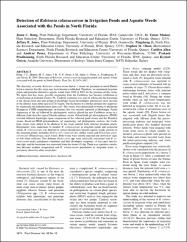Detection of Ralstonia solanacearum in Irrigation Ponds and Aquatic Weeds Associated with the Ponds in North Florida

Göster/
Erişim
info:eu-repo/semantics/openAccessTarih
2008Yazar
Hong, Jason C.Momol, M. Timur
Jones, Jeffrey B.
Ji, Pingsheng
Olson, Stephen M.
Allen, Caitilyn
Güven, Kıymet
Üst veri
Tüm öğe kaydını gösterÖzet
The discovery of exotic Ralstonia solanacearum biovar 1 strains on geranium in north Florida led to a concern that this strain may have become established. Therefore. we monitored irrigation ponds and potential alternative aquatic weeds from 2002 to 2005 for the presence of this strain. We report that this strain, possibly originating from the Caribbean, has become established in several ponds in Gadsden County, FL. Cladistic taxonomy was used to subclassify the bacterium at the species level into four groups or phylotypes based on multiplex polymerase chain reaction of the internal transcribed spacer (ITS) region. The bacterium was further divided into sequevars by sequencing the endoglucanase gene (egl). The strains were determined to belong to phylotype II/sequevar 4 NPB (nonpathogenic on banana) that was recently reported in Martinique. Partial sequencing of the egl followed by phylogenetic analysis placed the new Caribbean strains in a different clade than the typical Florida endemic strains. Pulsed-field gel electrophoresis (PFGE) revealed different haplotypes upon comparison of the collected pond strains and the Floridian strains. Based on PFGE polymorphism, egl sequencing, and phylogenetic analysis, the Caribbean strains were shown to be identical to the strain isolated from infected geranium plants. Experiments were undertaken to monitor R. solanacearum in irrigation ponds and associated weeds. R. solanacearum was detected in surface-disinfested common aquatic weeds growing in the irrigation ponds, including Hydrocotyle ranunculoides (dollar weed) and Polygonum pennsylvanicum (Pennsylvania smart weed). Both weeds were latently infected and showed no signs of wilt when collected. Two different Hydrocotyle spp. were artificially inoculated with R. solanacearum under greenhouse conditions and both developed symptoms 14 days post inoculation (dpi) and the bacterium was recovered from the tissues 42 dpi. There was a positive correlation between ambient temperature and R. solanacearum populations in irrigation water. as previously shown by other researchers.

















